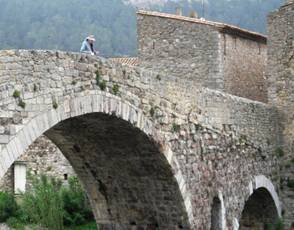
The WorldWorstTourist Paints France-Another Go with Art Master Tim Clark
Chapter 2-Bee Swarms and Bridges - Carcassonne and LaGrasse
May, 2015
Sunday
The Sunday afternoon schedule included Carcassonne, a nearby medieval walled city I had dreamed of painting since visiting twenty-five years earlier. With the morning free, I walked from one end of Floure to the other, not very far, actually, in search of the next perfect painting site. Sizing up the ubiquitous vineyard scenes I found one with everything I wanted, interesting shapes, skyline, mountains, and, of course, a vineyard. The one thing missing was shade, but a worthy sacrifice for such a beautiful view.
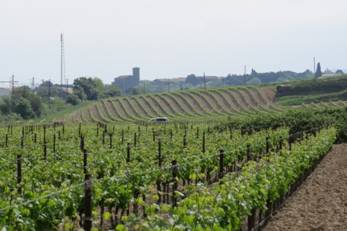
Beautiful vineyards had a way of drawing me in.

A Vineyard in Floure, 7x22, watercolor on paper, painted in Floure, France
In the back of my mind I was hoping the little French girl would show up again; however, my only audience today was a group of friendly horses that looked over my shoulder the entire time I was painting. They apparently thought that eventually I would feed them. Every time I would forget they were there, one of them would go “FFFFLLLLLUUUUUTTTTTT”.
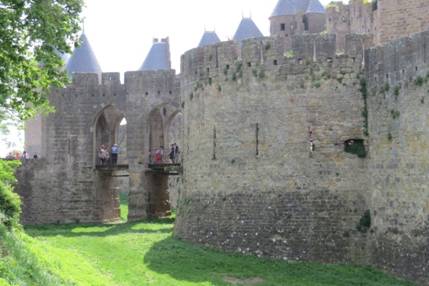
The north entrance to Carcassonne. The city has an inner wall and an outer wall for added defense.
The only problem with Carcassonne is its tourist reputation. The central city is usually packed with tourists all wanting a selfie in front of everything in the city. We broke up into small groups, walked through the city, toured the cathedral and searched for a painting opportunity. Places like Carcassonne tempt artists into becoming tourists. Unique vendors offering replica weapons, sundial jewelry, beautiful clothes, and exotic wines and liquors are just the beginning. Carcassonne is teeming with street art and architecture that is fun to study, sometimes providing a bit of irony. Pigeons almost always present a problem in such places, and this has been a problem for centuries. They hang around to find any crumb left by tourists. People have placed owls in strategic locations with the notion this would frighten pigeons away. I had a brief chuckle observing a pigeon comfortably sleeping while perched on an owl sculpture. The owl seems to be a bit flummoxed.
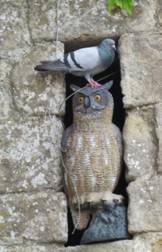
Owl sculptures have been used for centuries to scare pigeons away. Someone forgot to tell this sleepy pigeon to be frightened.
Uncrowded areas exist in Carcassonne in the space between the double walls, so five of us set up various painting stations and went to work. When I paint in such a place, I enter a timeless mental zone, which is like another dimension. I don’t notice tourists or almost anything except my subject and painting. Sitting on the outer wall, I had put my first wash on the painting and began adding details, when something I had not counted on happened. People around me were screaming and running and I heard voices yelling “Jim, get out of there!” Was a terrorist attack in the making? I sensed a change in the lighting and then realized the sky and every space around me was filled with bees. Still feeling the calm of the zone I made no sudden moves. Reflecting on my experience as a child with my grandfather’s many bee hives, I could see that no attack was imminent, and surmised that they wouldn’t bother me if I didn’t bother them.
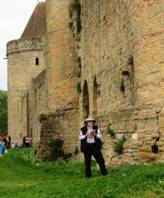
Making a few preliminary sketches before choosing a scene to paint.
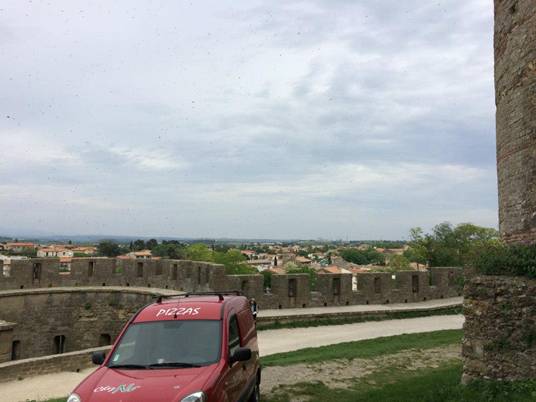
Painting Carcassonne in a swarm of bees-Observe the spots in the sky Photo by Clytie Rimberg
Everyone in the group had grabbed their gear and run, so I calmly put away my paints and slowly walked through the swarming bees back into the city with the group. We had earned ourselves a beer.
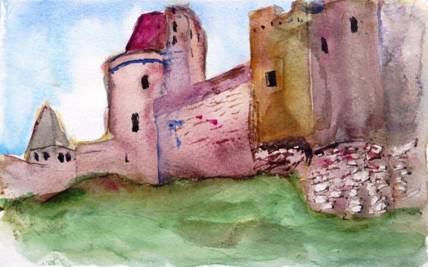
Between the walls of Carcassonne, 5x7, watercolor on paper, painted in Carcassonne, France
We joined the rest of the group and enjoyed a great dinner before returning to Floure.
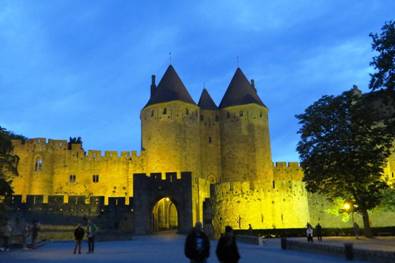
Leaving Carcassonne
Monday-LaGrasse
On Monday we visited the town of LaGrasse, another medieval town far enough off the beaten path that it was virtually deserted. To access it our bus driver took us over some of the infamous single lane highways. This one seemed to have fewer turnouts than would be needed, especially for buses, and I was relieved to see that we rarely met any traffic. La Grasse is another one of those places that has me addicted to plein air painting, and I could hardly wait to pull out a palette and go to work. Ancient rock walls always seem flower friendly, and I began seeing paintable ruins and walls everywhere. This is a phenomenon that oftentimes begs the following question, “Why do artists always want to paint old stuff? Why isn’t new stuff perceived as being equally beautiful?”
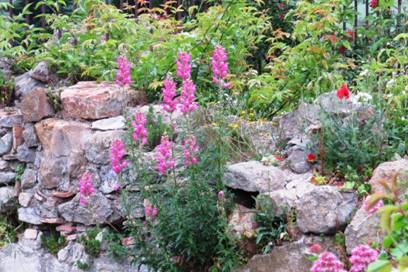
Ancient Rock Walls begging to be painted.
Somewhat to my disappointment, the day was heavily weighted with two abbey visits, lunch, and a demonstration, leaving not much painting time. Nevertheless, lunch at the Petite Maison was one of the most enjoyable lunches I have ever had, and the demonstration on designing the picture plane was one of the most useful of the entire trip. During lunch I practiced depth enhancement by partially obscuring objects, the best part of demonstration. It’s easy, these days, to identify artists in a group of ordinary people at lunch. Ordinary people stare at their I-phones, while checking their email; artists stare at their sketchbooks, drawing everything in sight.
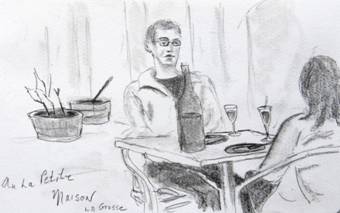
Lunch at the Petite Maison, pencil study practicing picture plane design and enhancing depth by partial obscurance.
Spicing up the lunch was a jovial French lady who kept correcting our English. When I asked her, “Can we get the bill?”; her response, with an impish smile, “I don’t know if you ‘can’ or not.”
Between Abbey visits, I painted the ruins near the Abbay St. Marie. One of the greatest challenges of a plein air painter is finding a place to sit that offers a good tradeoff between comfort, shade, space, and view of the scene to be painted. Much depends on the anticipated amount of time to be spent. Since there was no sun today, less than an hour to paint, and the best view was standing on the ancient LaGrasse bridge, my decision was made for me. It is a miracle that none of my brushes wound up in the river below because of the space limitation. Here is where much practice with short poses in life drawing pays off. I did a small quick study, first, and sketched a larger piece during drying times to paint later. As already mentioned, the quick study sometimes turns out to be a better painting than the larger more meticulous one. Again, it’s a tossup.
Painting from the Lagrasse Bridge
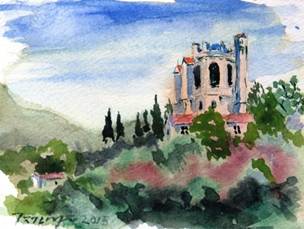
Ruins at LaGrasse Abbey, 5x7, watercolor study on paper, painted from the LaGrasse, France, old stone bridge.
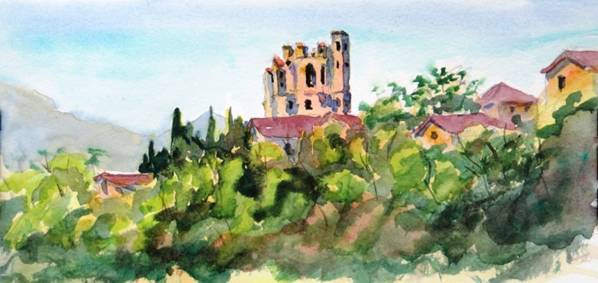
Ruins at Lagrasse Abbey 2, 7x12, watercolor on paper, drawn in LaGrasse, France, painted later
One of the problems with French food is the time required for a meal, usually a minimum of two and a half to three hours. After a fine meal at the Chateau, a few of us took a walk around the village. Not realizing that we were approaching the chateau lock down time, two of us chose to take one more look at a potential painting site for the next day. We returned to a closed gate that had been constructed to keep out people a lot more dangerous than us. Neither of us had brought our mobile phones with us. For a few moments, while banging hopelessly on the massive wooden gate, we imagined ourselves spending the night in the streets of Floure. Fortunately Gerry, the manager passed through the closed bar and responded to our pecking on the window, though not too happily.
Next-Chapter 3-Picnics, Picasso, and Patanque-Collioure
